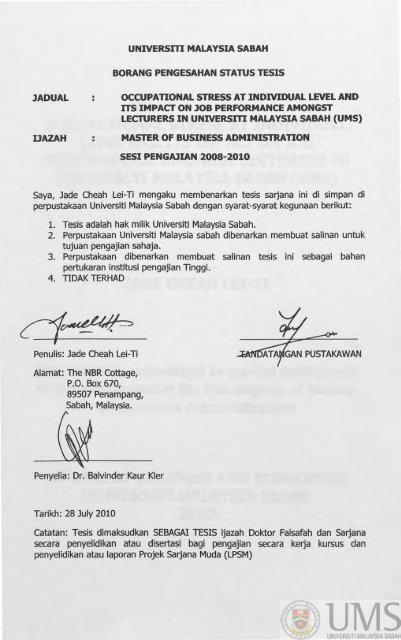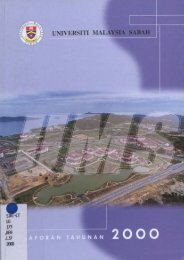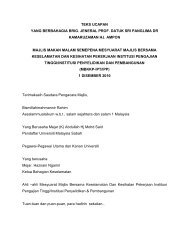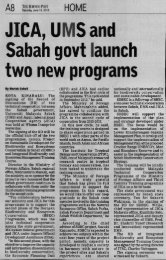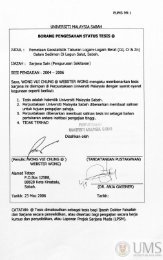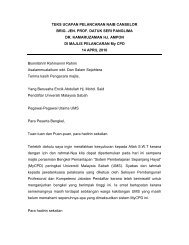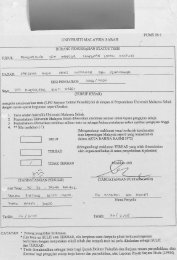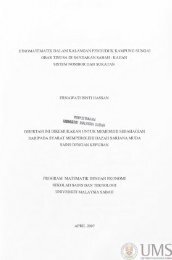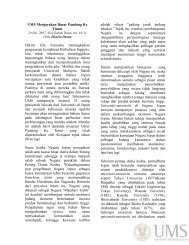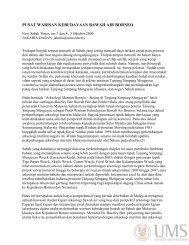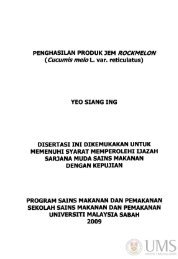UNIVERSITI MALAYSIA SABAH BORANG PENGESAHAN ... - UMS
UNIVERSITI MALAYSIA SABAH BORANG PENGESAHAN ... - UMS
UNIVERSITI MALAYSIA SABAH BORANG PENGESAHAN ... - UMS
You also want an ePaper? Increase the reach of your titles
YUMPU automatically turns print PDFs into web optimized ePapers that Google loves.
<strong>UNIVERSITI</strong> <strong>MALAYSIA</strong> <strong>SABAH</strong><strong>BORANG</strong> <strong>PENGESAHAN</strong> STATUS TESISlADUALDAZAHOCCUPATIONAL STRESS AT INDMDUAL LEVEL ANDITS IMPACT ON lOB PERFORMANCE AMONGSTLECTURERS IN <strong>UNIVERSITI</strong> <strong>MALAYSIA</strong> <strong>SABAH</strong> (<strong>UMS</strong>)MASTER OF BUSINESS ADMINISTRATIONSESI PENGAlIAN 2008-2010Saya, Jade Cheah Lei-TI mengaku membenarkan tesis sarjana ini di simpan diperpustakaan Universiti Malaysia Sabah dengan syarat-syarat kegunaan berikut:1. Tesis adalah hak milik Universiti Malaysia Sabah.2. Perpustakaan Universiti Malaysia sabah dibenarkan membuat salinan untuktujuan pengajian sahaja.3. Perpustakaan dibenarkan membuat salinan tesis ini sebagai bahanpertukaran institusi pengajian TInggi.4. TIDAK TERHADPenulis: Jade Cheah Lei-TIAlamat: The NBR Cottage,P.O. Box 670,89507 Penampang,Sabah, Malaysia.Penyelia: Dr. Balvinder Kaur KlerTarikh: 28 July 2010Catatan: Tesis dimaksudkan SEBAGAI TESIS ijazah Doktor Falsafah dan Sarjanasecara penyelidikan atau disertasi bagi pengajian secara kerja kursus danpenyelidikan atau laporan Projek Sarjana Muda (LPSM)
OCCUPATIONAL STRESS AT INDIVIDUALLEVEL AND ITS IMPACT ON lOBPERFORMANCE AMONGST LECTURERS IN<strong>UNIVERSITI</strong> <strong>MALAYSIA</strong> <strong>SABAH</strong> (<strong>UMS</strong>)lADE CHEAH LEI-TIDissertation submitted in partial fulfillmentof the requirement for the degree of Masterof Business AdministrationSCHOOL OF BUSINESS AND ECONOMICS<strong>UNIVERSITI</strong> <strong>MALAYSIA</strong> <strong>SABAH</strong>2010
DECLARATIONI hereby declare that the material in this thesis is my own except for quotations,excerpts, equations, summaries and references, which have been dulyacknowledged.17 JUNE 2010~~JOE CHEAH LEFriPE2008-8203C)ii
CERnFICAnONNAMEMATRIC NO.TITLEDEGREEVIVA DATEJADE CHEAH LEI-nPE20088203COCCUPAnONAL STRESS AT INDMDUAL LEVEL ANDITS IMPACT ON JOB PERFORMANCE AMONGSTLECTURERS IN UNIVERSITY <strong>MALAYSIA</strong> <strong>SABAH</strong> (<strong>UMS</strong>)MASTER IN BUSINESS ADMINISTRAnON29 TH JUNE 2010DECLARED BY1. SUPERVISORDR. BALVINDER KAUR KLERiii
ACKNOWLEDGEMENTFirstly, my outmost thanks go to God for granting me the wisdom, strengthand the opportunity to contribute to the upliftment of our knowledge aboutOccupational Stress at Individual Level and its impact on Job Performance throughthis study.I acknowledge and thank my supervisor, Dr. Balvinder Kaur Kler for herpatience, encouragement, endless advice, stimulating suggestions and support inall time of research and writing of this report; I would not have come this farwithout her. The experience, and knowledge that I have gained from this studyhave indeed helped me understand the true meaning of perseverance.I would also wish to express my gratitude to <strong>UMS</strong>' DS45 lecturers who werewilling to take some time off their heavy schedule to participate in the survey.Without their help, it would have been impossible for me to finish this work.In addition, to my lecturers, classmates in this MBA program, I thank you allfrom the bottom of my heart for all the help you have given especially in terms ofsharing your knowledge, information, and resources in our studies together. What Igained from this course was beyond my expectations whereby more doors ofopportunity has been opened to me.A special thank you goes out to two MBA graduates (my seniors), Mr. RogerBeliku and Mr. Rameshar Rajah for all the support and encouragement that wasgiven to me. It was a big motivation for me to maintain a positive attitude and keepmoving forward despite the hurdles faced.Finally, to all my family and friends, there are no words which are able toexpress my love and gratitude for all that they have done for me. Without theirencouragement and understanding it would have been impossible for me to finishthis report. I would particularly like to thank those who never advised me to quit.They had more faith in me than could ever be justified by logical argumentThank you and God bless.JADE CHEAH LEI-TI29 TH JUNE 2010IV
ABSTRACTOCCUPATIONAL STRESS AT INDIVIDUAL LEVEL AND ITS IMPACT ONlOB PERFORMANCE AMONGST LECTURERS INUNIVERSm <strong>MALAYSIA</strong> <strong>SABAH</strong> (<strong>UMS</strong>)This study aims to determine the immediate factors in occupational stress atindividual level that impact job performance amongst lecturers holding the post ofDS45 at Universiti Malaysia Sabah (<strong>UMS</strong>). The objectives of this study wereachieved by examining the relationship between job perfonnance (dependentvariable) and five factors identified as independent variables which include workingcondition, resources and communication, workload, work-relationship with theDean, and work-relationship with colleagues. Results from the online questionnairecollected from 228 respondents were analyzed using the multiple regressionanalYSis. The analysis revealed that 31.1 percent and 45.1 percent of the variancewere explained by model 1 and model 2 respectively, with working condition,workload, work-relationship with the Dean, and work-relationship with colleagues(total four factors) significant. Although the relationship between dependentvariable and independent variables when regressed together produced anacceptable result, further research should be done in order for this model to beproposed as a general model for developing a framework regarding occupationalstress at individual level and job perfonnance among university lecturers. It ishoped that this study has contributed to studies in this field and played its part inpaving the way for future studies to identify a more sustainable and replicablemodel, hence aSSisting the higher education industry to face the challenge of the21 st century.v
ABSTRAKKajian ini bertujuan untuk mengenalpasti faktor-faktor stres peketjaan pada tahapindividu yang mempengaruhi prestasi peketjaan di kalangan pensyarah universityyang memegang gred DS45 di Universiti Malaysia Sabah (<strong>UMS</strong>) secara langsung.Objektif untuk kajian ini dicapai dengan menganalisis perhubungan antara prestasiketja dengan faktor-faktor yang telah dikenalpasti iaitu suasana ketja, sumber dankomunikasi, beban tugas, hubungan pensyarah dengan Dekan, dan hubunganpensyarah dengan rakan seketja. Hasil daripada pemantauan online yang dikutipdaripada 228 responden dianalisiskan dengan menggunakan analisis 'multipleregression~ 1a menunjukkan bahawa 31.1 peratus dan 45.1 peratus varians dapatdipenuhi oleh model 1 dan model 2 masing-masing, dengan suasana ketja, bebantugas, hubungan pensyarah dengan Dekan, dan hubungan pensyarah denganrakan seketja, (jumlahnya empat faktor) didapati signilikan. Walaupunperhubungan antara pembolehubah begantung dan pembolehubah yang tidakbergantung apabila diuji bersama memberi hasil yang diterima, penyelidikan lanjutharus dijalankan sekiranya model ini ingin dicadangkan sebagai model am bagitujuan pembangunan rangka ketja berkaitan stres di peketjaan pada tahap individudan prestasi ketja. Adalah diharapkan bahawa kajian ini dapat memberi sumbangankepada penyelidikan dalam bidang ini, dan memainkan peranan dalam membukajalan untuk kajian-kajian untuk mengenalpasti model yang lebih lengkap dansempuma pada masa hadapan, dan selanjutnya membantu industri pengajiantinggi menghadapi cabaran-cabaran sengit di abad ke-21 ini.vi
TABLE OF CONTENTSPageTITLEDECLARA110NCER11FICA110NACKNOWLEDGEMENTABSTRACTABSTRAKTABLE OF CONTENTSUST OF FIGURESUST OF TABLESUST OF APPENDICESCHAPTER 1 : INTRODUCllON1.0 Overview of Higher Education Industry in Malaysia1.1 Problem Statement1.2 Research Objectives1.3 Scope of Study1.4 Significance of Study1.5 Operational Definitions of Key Variables In This Study1.5.1 Job Performance1.5.2 Working Conditions1.5.3 Resources and Communication1.5.4 Workload1.5.5 Work-Relationship with the Dean1.5.6 Work-Relationship with Colleagues1.6 Organization of the ReportCHAPTER 2 : LITERATURE REVIEW2.0 Introduction2.1 Conceptualization of Stress2.2 Job Performance in an Organization2.3 Occupational Stress at Individual level2.4 Factors Intrinsic to the Job2.4.1 Working Conditions2.4.2 Resources and Communication2.4.3 Workload2.5 Interpersonal Relationships at Work2.5.1 Work-Relationship with the Dean (Boss)2.5.2 Work-Relationship with Colleagues2.6 The Link between Occupational Stress and Job Performance2.7 SummaryCHAPTER 3 : RESEARCH METHODOLOGY3.0 Introduction3.1 Research Framework3.1.1 Dependent Variableiiiiiivvviviixxixii1244566666666881012141516171919212123242426vii
3.1.2 Independent Variables 263.2 Research Hypotheses 273.3 Research Design 283.4 Unit of Analysis 283.5 Sampling Design 283.5.1 Location of Study and Population 283.5.2 Sampling Technique 303.5.3 Sampling Size 303.6 Instrument Design 313.6.1 Questionnaire 323.6.2 Control Measures 343.7 Data Collection Method 353.8 Data Analysis Method 363.9 Summary 37CHAPTER 4 : ANALYSIS OF FINDINGS4.0 Introduction 384.1 Profile of Respondents 384.2 Normality Test Analysis 414.2.1 Dependent Variable and Independent Variables Normality 414.3 Reliability Test Analysis 424.4 Multiple Regression Analysis 444.4.1 Multiple Regression Model-l: Factors Intrinsic to the Job 444.4.2 Multiple Regression Model-2 : Interpersonal Relationships 45at Work4.5 Hypotheses Testing 464.6 Summary 48CHAPTERS : DISCUSSION AND CONCLUSION5.0 Introduction 515.1 Recapitulation of the Study Sl5.2 Discussion of Rndings 535.2.1 Factors Intrinsic to the Job 575.2.2 Working Condition 575.2.3 Resources and Communication 585.2.4 Workload 595.2.5 Interpersonal Relationships at Work 595.2.6 Work-Relationship with the Dean 605.2.7 Work-Relationship with Colleagues 605.3 Implications of the Study 615.4 Limitations of Study 625.4.1 This study is strictly present oriented, no future oriented 63elements5.4.2 Umited scope of study 635.4.3 Length of questionnaire and accuracy of respondents' 63feedback5.5 Suggestions for Future Research 635.6 Conclusion 65Vlll
REFERENCESAPPENDICES6780ix
UST OF FIGURESRgure 2.1Rgure 2.3Figure 3.1Figure 3.5.3Figure 5.1Figure 5.2A Model of Stressors, Stress and OutcomesThe terms used by Ivancevich et at (2008) and, Jacksonand Rothmann (2006)Theoretical Research Framework: Occupational stress atindividual level impacting job performance amongst lecturersin University Malaysia Sabah (<strong>UMS</strong>)Krejcie and Morgan (1970) formula to determine sampling sizeDifferentiation of Job Performance (task and contextual)between Factors Intrinsic to the Job and InterpersonalRelationships at WorkTheoretical Research Framework: Occupational Stress atIndividual Level and its Impact on Job Performance amongLecturers in University Malaysia Sabah (<strong>UMS</strong>)Page91325315356x
LIST OF TABLESPageTable 3.5.1 Total Academic Staff According to Employment Grade 29as of March 2010Table 4.1 Demographic Profile of the respondents (Lecturers 39holding DS45 grade in Universiti Malaysia Sabah)Table 4.2.1 Summary of Normality test on dependent variable and 42independent variablesTable 4.3 Summary of Reliability Test Analysis Results 43Table 4.6 Summary of the Findings from Hypotheses Te$ting 49Xl
UST OF APPENDICESPageAPPENDIX 1.0 : Permission Letter 80APPENDIX 2.0 : Questionnaire 81APPENDIX 3.0: Total Responses Received 92APPENDIX 4.0 : Frequencies for Profile of Respondents 93APPENDIX 5.0 : Normality Test Analysis 96APPENDIX 5.1 : Normality Test for Dependent Variable and Independent 96VariablesAPPENDIX 6.0 : Reliability Test Analysis 101APPENDIX 6.1 : Reliability Test for Job Performance 101APPENDIX 6.2 : Reliability Test for Working Condition 101APPENDIX 6.3 : Reliability Test for Resources and Communication 102APPENDIX 6.4 : Reliability Test for Workload 102APPENDIX 6.5 : Reliability Test for Work-Relationship with the Dean 103APPENDIX 6.6 : Reliability Test for Work-Relationship with Colleagues 103APPENDIX 7.0 : Multiple Regression Modell-Factors Intrinsic to the Job 104APPENDIX 7.1 : Residual Statistics 104APPENDIX 7.2 : Normal P-Plot of Regression Standardized Residual 104APPENDIX 7.3 : Scatterplot 105APPENDIX 7.4 : Model Summary 105APPENDIX 7.5 : ANOVA 106APPENDIX 7.6 : Coefficients 106APPENDIX 8.0 : Multiple Refression Model 2-Interpersonal Relationships at 107WorkAPPENDIX 8.1 : Residual Statistics 107APPENDIX 8.2 : Normal P-Plot of RegreSSion Standardized Residual 107APPENDIX 8.3 : Scatterplot 108APPENDIX 8.4 : Model Summary 108APPENDIX 8.5 : ANOVA 109APPENDIX 8.6 : Coefficients 109xii
CHAPTER 1INTRODUCTION1.0 OVerview of Higher Education Indusby in MalaysiaAs an industry, higher education plays a significant role in the economy. The highereducation industry provides a competitive force of the marketplace in which thisindustry affects almost all of us albeit as students, parents, employees, employers,and citizens of scientific, medical and technological research. Higher educationindustry provides not only education but with it the essential facilities andInfrastructures for lectures such as lecture rooms, conference facilities, researchcentre, and laboratories in which are equipped with presentation eqUipment suchas LCD projectors, OHP projectors, internet connectivity and sound system.The industry and its activities are closely linked to a country's economy eventhough it is a complex and diverse industry as it combines a dominant public sectorof state universities and also the private sector of universities, community colleges,and polytechnics that educate a majority of all students. Significantly, not only arelecturers associated with higher education industry but other parts of theprofessional services industry are well closely linked to the higher educationindustry such as the finanCial, administrative, security and transportation, andmedical professions. Therefore, higher education is too important to be left out ofthe marketplace as it is increasingly being relied upon to solve economic and socialproblems.Access to higher education for all young people, regardless of their familycircumstances is a vital need-based element of the social mission (Turk, 2008;MacGregor, 2009). However, higher education is not meant simply as a privateinterest to each individual but it brings benefit to other people. Regardless ofownership form whether it is a public university or private higher educationinstitute, this industry is about competition for the number of students the institutehas, which is sometimes viewed as part of the educational mission but sometimessimply viewed as revenue sources to the country.
According to Noordin and Jusoff (2009), education is one of the mostimportant institutional organizations of a nation and as it oversees issues onnational agenda, its effective running depends firmly on its coordination in thedirection of societal expectation. The success of its' educational programs arefounded based on its important contributions of effort, involvement, and mostimportantly on the overall academic staff professionalization.In Malaysia, the higher education industry consists of four segments whichare the public universities, private universities, polytechnics and communitycolleges. Currently, there are a total of 20 public universities, 345 privateuniversities, 27 polytechnics, and 59 community colleges established under theUniversities and Universities College Act (MOHE, 2010).1.1 Problem StatementThe nature of work is changing at whirlwind speed and perhaps now more thanever before, occupational stress poses a threat to the health of workers and, intum, to the health of the organizations (NIOSH, 1999). It is noted that stress is inthe eyes of its beholder whereby some employers would assume that stressfulworking conditions are a necessity which might assist productivity and profitabilityin today's economy. However, stressful working conditions could also lead todecreased productivity if it is not handled properly.Winefield (2000) stated that recent studies done globally on stress amongacademic staff in higher education industry indicate that the phenomenon ofoccupational stress in universities is increasing and widespread. In Malaysia, thenumber of universities has increased tremendously over the past few years and asthis number increases, university academic staff may face more problems in theirjob as management faces competitive pressure from other universities (Ahsan et al,2009).As institutions of higher learning and a high-level organization, universitiesneed to focus on the quality of management, teaching and learning. Ivancevich etat (2008) indicate that very few organizations are likely to escape the impact of2
stress among its employees at the workplace. In a higher education industry, theconfrontational nature of educational lectures produces significant levels of stressfor the lecturers and the high levels of stress amongst lecturers could damageproductivity (Huda et al, 2004).At the same time, there is also pressure from Malaysia's Ministry of HigherEducation in which they have established the Accelerated Programme forExcellence (APEX) as they desire to have more of the country's universities to beon-par with the best universities in the world. Generally, the world's well knownuniversities are divided into three groups which are APEX University, Elite Universityand Competitive University (MOHE, 2010).Universiti Sains Malaysia (USM) which is the second public universityestablished in Malaysia located in Penang became the role model for all universitiesin Malaysia when it was recognized as an APEX University on 27tn August 2008 byleading in all aspects of the higher education industry with its characteristics of anAPEX university such as excellent leadership, faculties, facilities, and studentacademic excellence (MOHE, 2010). These days, most universities especially in thepublic sectors strive to excel and be the next APEX University in Malaysia whichmay cause the university academic staff to face plenty of stress that could affecttheir satisfaction, physical or mental health and ultimately cause a significantimpact on the individual's job performance (Noordin and Jusoff, 2009; Ahsan et al,2009).In tandem with the aspiration in preparing Malaysia as a centre ofexcellence for higher education, Ministry of Education, Malaysia (2001) stated thatit is recommended by the year 2005, 75 percent of the academic staff in localinstitution of higher education must possess doctoral qualifications. According toInsightSabah (2009), Colonel Professor Datuk Dr. Kamaruzaman Hj. Ampon, ViceChancellor to the ninth public university in Malaysia - Universiti Malaysia Sabah(<strong>UMS</strong>) stated that the university is still a long way from achieving that mark due tothe university's performance that does not meet the criteria to be recognized as anAPEX university. This ultimately increases the intensity of the pressure on lecturers,3
which leads us to the heart of this research, to identify the occupational stress atindividual level that impacts job performance amongst lecturers in UniversitiMalaysia Sabah (<strong>UMS</strong>).This research examines the relationship between factors intrinsic to the joband interpersonal relationships at work, and job performance amongst lecturers inUniversiti Malaysia Sabah (<strong>UMS</strong>). The next section presents the research objectives.1.2 Research ObjectivesThe overall objective of the study is to determine the relationship betweenoccupational stress at individual level consisting of two independent variables(Factors Intrinsic to the Job, and Interpersonal Relationships at Work) and jobperformance among lecturers in Universiti Malaysia Sabah (<strong>UMS</strong>). The specificobjectives are to determine:-i. The relationship between working conditions and job performance amonglecturers in Universiti Malaysia Sabah (<strong>UMS</strong>).ii. The relationship between resource and communication, and jobperformance among lecturers in Universiti Malaysia Sabah (<strong>UMS</strong>).iii. The relationship between workload and job performance among lecturers inUniversiti Malaysia Sabah (<strong>UMS</strong>).iv. The relationship between work-relationship with Dean and job performanceamong lecturers in Universiti Malaysia Sabah (<strong>UMS</strong>).v. The relationship between work-relationship with colleagues and jobperformance among lecturers in Universiti Malaysia Sabah (<strong>UMS</strong>).1.3 Scope of StudyThe scope of this study is being limited to lecturers holding the post of DS45 underthe Malaysia Remuneration System (SSM) in Universiti Malaysia Sabah (<strong>UMS</strong>),Malaysia's ninth public institution of higher education which has plans to gain APEXuniversity status, located in Kota Kinabalu - the capital city for the state of Sabah inEast Malaysia (<strong>UMS</strong>, 2010), with the target to obtain valuable local data.4
In addition, the scope in the literature review of this study focused on twokey areas which are job performance and occupational stress focusing on factorsintrinsic to the job and interpersonal relationships at work, and the linkage betweenoccupational stress and job performance.1.4 Significance of StudyThe results of this study made important implications for the public institution ofhigher education such as Universiti Malaysia Sabah (<strong>UMS</strong>). Occupational stress iswidespread and increasingly costly both to the individual's job performance andorganization's productivity. Therefore, this study is significant to assist themanagerial level of higher education organization to manage occupational stress atpublic institution of higher education.Throughout this study, managerial level of higher education organizationcan gain a clearer understanding on what is the occupational stress faced bylecturers at its institution. Management competency is a concern that must not betaken lightly by the managerial level as occupational stress may affect thesubordinate/employees effiCiency and productivity which would be damaging to theindividual's job performance and ultimately affect the organization's overallperformance (Gillespie et a/., 2001).This study hoped to serve as guidance and a stepping stone for furtherstudies in various aspects of improving the quality and productivity in the highereducation industry as a whole by understanding the level of stress its employees ofthe twenty first century is experiencing and how it is impacting their jobperformance.Finally, this study also contributes to the global literature on stress and jobperformance amongst lecturers in the Higher Education Institution previouslycarried out by researcher such as Broadbridge (2002), Jackson and Rothmann(2006), Kazmi et a/(200S) and Mostert et a/(2000).5
1.5 Operational Definitions Of Key Variables In This Study1.5.1 lob PerfonnanceJob performance refers to the overall evaluation of how well an individual ismeeting the organization's expectation (Allen and Griffeth, 1999).1.5.2 Working ConditionsWorking conditions refers to the extent to which the physical working environmentis comfortable and supportive of productivity (Ivancevich et ai, 2008).1.5.3 Resources and CommunicationResources and communication refers to the availability of equipment/resources atwork and the effectiveness of communication in the workplace (Johnson et al,2005).1.5.4 WorkloadWorkload refers to all activities that take the time of the individual and are relatedto professional duties and responsibilities (Hashim et ai, 2006).1.5.5 Work-Relationship with the DeanWork-relationship with the Dean relates to the individual's relationship andinteraction with his or her boss, namely the Dean in the workplace (Meiners andMiller, 2004).1.5.6 Work-Relationship with ColleaguesWork-relationship with colleagues relates to the individual's relationship andinteraction with his or her colleagues in the workplace (Viemes and Guzman, 2005)1.6 Organization of the ReportThe report is organized into five chapters, which is Introduction, Literature Review,Research Methodology, Analysis of Findings, and Discussion and Conclusionrespectively.6
Chapter One, Introduction, provides an overview of the Higher EducationIndustry in Malaysia. It subsequently derives the Problem Statements, ResearchObjectives, Scope of Study, Significant of Study, Operational Definitions of KeyVariables in this study and Organization of Study.Chapter Two, Uterature Review, reviews studies on occupational stress andjob performance in the Higher Education Institute previously conducted by othersand their findings. Some of these previous studies are nearly the same as this studywith focus on different industries in different countries or stated, while some otherstudies focus on other factors that impacts job performance in the higher educationindustry. The dependent and independent variables used in this research werederived from the literature review and the relationship between them will bediscussed further in Chapter Two.Chapter Three, Research Methodology discusses the Research Framework,Hypotheses, methods and questionnaires used to conduct the survey for theresearch. Chapter Four presents the Analysis of Rndings and finally, the reportconcludes in Chapter Rve, Discussion and Conclusion.7
CHAPTER 2LITERAllJRE REVIEW2.0 IntroductionThis chapter reviews the literature conducted on the relationships amongoccupational stress and job performance. The aim of this chapter is to evaluate theliterature and define the meaning of occupational stress at individual level and itsaffect on job performance. Next, the chapter justifies the choice of independentvariables such as factors intrinsic to the job and interpersonal relationships at workas almost everyone experiences stress at work.2.1 Conceptualization of StressStress is certainly nothing new under the sun as Ivancevich et a/ (2008) stated thateven our cave-dwelling ancestors faced stress every time they left their caves andencountered their enemy, the saber-toothed tigers. However, the saber-toothedtigers of yesteryears have since been replaced by another predator known as the"work predator" that creates stress for individuals on the job.In this current era, a key ''work predator" is known as occupational stress.One of the complicating issues in understanding occupational stress is that the listof potential stressors is almost infinite. As such, the main focus was on identifyingliterature which related to occupational stress (independent variables) at individuallevel which affects the individual's job performance (the dependent variable). Thisfocus area is important for Organizational Behavior and Management as the impactof occupational stress on an individual's job performance would often times lead toindirect costs to organizations such as absenteeism, turnover, lower productivity,and quality problems.
Figure 2.1: A Model of Stressors, Stress and OutcomesBehavioral• Satisfaction• Petfonnance• Absenteeism• Turnover• Accidents• Substance Abuse• Health care OalmsIndividual Level• Role Conflict• Role Overload• Role Ambiguity• Responsibility forPeople• Harassment• Pace of ChangeCognitive• Poor decisionmaking• Lack ofconcentration• Forgetfulness• Frustration• ApathyPhysiological• Increased bloodpressure• Immune System• High Cholesterol• Coronary heartdisease• GastrointestinalsystemSource: Ivancevich et a/(2008)9
Figure 2.1 shows the model of stressors, stress and outcomes illustrated byIvancevich et at (2008). It shows the link among occupational stressors atindividual level, stress and outcomes. The experience from the stressors leads tostress which produces outcomes that are divided into three categories which arebehavioral, cognitive and physiological.Previous literature focused on the common link of various occupationalstressors at individual level with lower levels of job satisfaction and higher tumover(Kinman, 2001), ways of coping the stressors and the effect on job performancefocusing more on other professions such as nursing (lambert et at, 2004; Nizami etal, 2006) and customer service (Oole and Schroeder, 2001; Tuten andNeidermeyer, 2004; Netemeyer et al, 2005) to name a few. Moreover, researchexamining the impact of stress levels on the productivity of staff and universities issparse (Jacobs et al, 2007). Although there is increasing evidence from researchthat indicates the assodation between occupational stress and job performanceexists, there is little attention paid to a specific occupation.According to De Jesus and Conboy (2001), it was found that educatorsexperience higher levels of stress than other professional groups and Chalmers(1998) stated that since 1994, there were Significant differences in stress levelsbetween groups of educators in which lecturers were the most stressed group,followed by senior lecturers, and tutors while professors were the least stressedqroup. Thus, this study looked upon university academic staff specifically lecturersas one professional qroup worthy of consideration.2.2 lob Perfonnance in an OrganizationAllen and Griffeth (1999) explained that job performance refers commonly to theoverall evaluation of how well an individual is meeting the organization'sexpectations. Job performance is an extremely vital criterion that relates toorqanizational success or outcomes. In a study done by Befort and Hattrup (2003),they found that lob performance is a multidimensional construct in which twoqeneral factors received more attention, namely task performance and contextualperformance which supports Viswesvaran and Ones' (2003) findinqs.10
Task performance refers to the set of core duties and tasks that are centralto a particular job (Ferris et al. 2008). This includes behaviors that contribute to thecore transformation and maintenance activities in an organization which ispresented by the job itself (Motowidlo and Schmit, 1999). Ferris et at (2008) statedthat task performance can be distinguished by the explicitly prescribed tasks andduties typically provided in job descriptions. This form of task performance can belinked to the factors intrinsic to the job such as conforming to the workingcondition, managing the demand in workload, and carrying out activities involvingresources and communication.On the contrary, contextual performance refers to behaviors whichcontribute to the culture and climate of the organization (Befort and Hattrup,2003). Examples of contextual performance behaviors are volunteering for extrawork, persisting with enthUSiasm, following rules and procedures, helping andcooperating with others, and supporting or defending the organization (Motowidloand Schmit, 1999). This form of behavior can be linked to the interpersonalrelationships at work such as work-relationship with boss and colleagues.In a workplace, Levey (2001) state that job performance is viewed as theresult of three factors working together: skill, effort and the nature of workconditions. The skill in dude knowledge, abilities and competendes the employeebrings to the job while effort is the degree of motivation the employee puts forthtoward getting the job done, and the nature of work conditions is the degree ofaccommodation of these conditions in facilitating the employee's productivity.However, Ivancevich et at (2008) conceptualizes the definition ofperformance as a function of the capadty to perform, the opportunity to perform,and the willingness to perform. Ivancevich et at (20OS) identified that the capacityto perform relates to the degree to which an individual possesses task-relevantknowledge, skills, abilities, and experiences which means to say that high levels ofjob performance are only possible when the employee knows what is supposed tobe done and how to do it. The opportunity to perform is another critical ingredientin the job performance recipe in which the individual's job performance is11
REFERENCESAbuAlrub, R.F. 2004. Job stress, job performance and social support amonghospital nurses. Joumal of Nursing Scholarship, Volume 36 (1): 73-78.Adler, D.A., McLaughlin, TJ., Rogers, W.H., Chang, H., Lapitsky, L., and Lerner, D.2006. Job performance deficits due to depression. l77e American Joumal ofPsychiatry, Volume 163: 1569-1576.Ahsan, N. , Abdullah, Z., Yong, D.G.F., Alam, S.S. 2009. A Study of Job Stress onJob Satisfaction among University Staff in Malaysia: Empirical Study.European Joumal of Social Sciences, Volume 8(1): 121-131.Allen, D.G., and Griffeth, R.W. 1999. Job Performance and Turnover: A Review andIntegrative Multi-Route Model. Human Resource Management Review,Volume 9 (4): 525-548Alman, I., Loh, L.C.S., Ajis, M.N., Dollah, N.F., and Boerhannoeddin, ~. 2009.Relationship between Supervisor's Role and Job Performance in theWorkplace Training Program. Journal of Scientific Annals of the ''Alexandruloan Cuza" University of lasi: Economic Sciences Series, Volume 2009(LVI): 237-251.Bakker, A.B., Demerouti, E., De Boer, E. and Schaufeli, W.B. 2003. Job demandsand job resources as predictors of absence duration and frequency. Journalof Vocational Behavior, Volume 62: 341-356.Barkhuizen, N. and Rothmann, S. 2008. Occupational stress of academic staff inSouth African higher educational institutions. South African Joumal ofPsychology, Volume 38 (2): 321-336.67
Befort, N. and Hattrup, K. 2003. Valuing Task and Contextual Performance:Experience, Job Roles, and Ratings of the Importance of Job Behaviors.Applied H.R.M. Research, Volume 8(1): 17-32.Broadbridge, A. 1998. Stress in retailing: preliminary analysis of the experiences ofretail managers. Institute for Retail Studies, Working paper 9803, Universityof Stirling.Broadbridge, A. 2002. Retail managers: their work stressors and coping strategies.Joumal of Retailing and Consumer Services, Volume 9: 173-183.Brooks, M.V. 2003. Health-Related Hardiness and Chronic Illness: A Synthesis ofCurrent Research. Nursing Forum 38: 11-20.Cartwright, S. and Cooper, c.L. 2002. ASSET: An Organisational Stress ScreeningTool- The Management Guide. Manchester, UK: RCL Ltd.Chalmers, A. 1998. Workload and Stress in New Zealand Universities in 1998: afollow-up to the 1994 study. Wellington: New Zealand Council forEducational Research Distribution.Chan, Y.H. 2005. Basic Statistics for Doctors. Singapore Medical Joumal, Volume44(6): 280-285.Chang, c.P. and Tseng, Y-M. 2009. An Exploration of Job Stress among AcademicHeads in Taiwanese Universities. Social Behavior and Personality: anIntemational Joumal. Volume 37(5): 583-589.Chi, S.c. and Lou 5.5. 2000. Which is More Important: Relationships with Boss orwith Colleagues? Examining Taiwanese Employees 'Justice Perceptions onCo-workers' Punitive Events. Proceedings of The Second Asia Academy ofManagement Conference. Singapore.68
Chua, L.c. 2006. Sample Size Estimation using Krejcie and Morgan and CohenStatistical Power Analysis: A Comparison. Jurnal Penyelidikan IPBL, Volume7: 78-86.Coakes, S.J., Steed, L. and Ong, C. 2009. SPSS: Analysis without anguish: version16.0 for Windows. John Wiley & Sons Australia, Ltd.Coetzee, S.E. and Rothmann, S. 2005. Occupational Stress, OrganisationalCommitment and III Health of Employees as a Higher Education Institutionin South Africa. South African Journal of Industrial Psychology, Volume31(1): 47-54.Conley, S. and Woosley, S.A. 2000. Teacher role stress, higher needs and workoutcomes. Journal of Educational Administration, Volume 38(2): 179-201.Cramer, P. 2000. Defense Mechanisms in Psychology Today: Further Processes forAdaptation. American Psychologist 637-646.De Jesus, S.N. and Conboy, J. 2001. A stress management course to preventteacher distress. 777e International Journal of Educational Management,Volume 15(3): 131-137.Devonport, T.J., Biscomb, K., and Lane, A.M. 2008. Sources of Stress and the Useof AntiCipatory, Preventative and Proactive Coping Strategies by HigherEducation Lecturers. Journal of Hospitality, Leisure, Sport and TourismEducation, Volume 7(1): 70-81.Dijkstra, M.T., Van Dierendock, D., and Evers, A. 2005. A Responding to Conflict atWork and Individual Well-Being : The mediating role of flight behavior andfeelings of helplessness. European Journal of Work and OrganizationalPsychology, Volume 14(2): 119-135.69
Dole, C. and Schroeder, R.G. 2001. The impact of various factors on thepersonality, job satisfaction and turnover intentions of professionalaccountants. Managerial Auditing Journal, Volume 16(4): 234-245.Erkutlu, H.V. and Chafra, J. 2006. Relationship between leadership power basesand job stress of subordinates: example from boutique hotels. Journal ofManagement Research News, Volume 29(5): 285-297.Ferris, G.R., Munyon, T.P., Basik, K., Buckley, M.R. 2008. The performanceevaluation context: Social, emotional, cognitive, political, and relationshipcomponents. Human Resource Management Review, Volume 18: 146-163.Fevre, M.L., Matheny, J., and Kolt, G.S. 2003. Eustress, distress and interpretationin occupational stress. Joumal of Managerial Psychology, Volume 18(7):726-744.Forrest, E. 1999. Internet Marketing Research. Sydney: McGraw-HiliGillespie, N.A., Walsh, M., Winefield, A.H., Dua, J., and Stough, C. 2001.Occupational Stress in Universities: Staff perceptions of the causes,consequences and moderators of stress. Work & Stress, Volume 15(1): 53-72.Gumport, P. 2000. Academic Restructuring: Organizational Change and InstitutionalImperatives. Higher Education. Volume 39(1): 67-91.Gupta, B. and Tyagi, A. 2009. Employees' perception of workplace stressors andtheir attitude towards work and organization: a study of Indian managers.International Journal of Indian Culture and Business Management, Volume2(6): 686-706.70
Gwinner, C. 2010. Infosurv White Paper: 5-point vs. 6-point Ukert Scales. Infosurv.Retrieved on March 15, 2010 fromhtto:/Iwww.infosurv.com/images/Ukert Scale Debate.pdfHashim, R.H., Abdul Hamid, J., Selamat, M.H. Ibrahim, H., Abdullah, R., Mohayidin,M.G. 2006. Using Algorithmic Taxonomy to Evaluate Lecturer Workload.Journal of Knowledge Management Practice, Volume 7(2). Retrieved onFebruary 1 st , 2010 from htto:/Iwww.tlainc.com/articl115.htmHuang, K-Y. and Mujtaba, B.G. 2009. Stress, task, and relationship orientations ofTaiwanese adults: an examination of gender in this high-context culture.Journal of International Business and Cultural Studies. 1-12.Huda, B.Z., Rusli, B.N., Naing, L., Tengku, M.A., Winn, T., and Rampal, K.G. 2004.A Study of Job Strain and Dissatisfaction Among Lecturers in the School ofMedical Sciences Universiti Sains Malaysia. Southeast Asian J Trop MedPublic Health March 2004 Volume 35(1): 210-218.InsightSabah. 2009. <strong>UMS</strong>: An enigma no more, perhaps. In InsightSabah: TheVoice of Sabahans (InsightSabah). Retrieved January 29, 2010 fromhtto:!linsightsabah.gov.my/articie/printJ13Ismail, A., Yao, A., and Yunus, N.K.Y. 2009. Relationship between occupationalstress and job satisfaction: An empirical study. The Romanian EconomicJournal. Year XII (4). Pg: 3-29.Ivancevich, J.M., Konopaske, R., Matteson, M.T. 2008, Organizational Behavior andManagement, Eight Edition. New York: McGraw-Hili/IrwinJackson, L. and Rothmann, S. 2006. Occupational stress, organizationalcommitment, and ill-health of educators in the North West Province. SouthAfrican Journal of Education, Volume 26(1): 75-95.71
Jacobs, P.A., Tytherleigh, M.Y., Webb, c., and Cooper, c.L. 2007. Predictors ofWork Performance Among Higher Education Employees: An ExaminationUsing the ASSET Model of Stress. Intemational Joumal of StressManagement, Volume 14(2): 199-210.Jamal, M. and Saba, V. V. 2000. Job stress and burnout among Canadian managersand nurses: An empirical examination. Canadian Joumal of Public Health ,Volume 91(6): 454-458.Johnson, J. 2002. A public agenda survey - staying ahead of the game. EducationalLeadership, Volume 59: 26-30.Johnson, S., Cooper, c., Cartwright, S., Donald, 1., Taylor, P., Millet, C. 2005.OBSERVATIONS PIECE : The experience of work-related stress acrossoccupations. Joumal of Managerial Psychology, Volume 20(2): 178-187.Kazmi, R., Amjad, S., and Khan, D. 2008. Occupational Stress and its Effect on JobPerformance. A Case Study of Medical House Officers of District Abbottabad.Joumal Ayub Medical College Abbottabad, Volume 20(3): 135-139.Kehoe, C.M., and Pitkow, J.E. 1996. Surveying the territory: GVU's five WWW usersurveys. Tl7e World Wide Web Jouma~ Volume 1(3): 77-84. RetrievedMarch 25, 2010 fromhtto://cc.qatech.edu/qvu/user surveys/papers/w3j.html.Kinman, G. 1996. Occupational stress and health among lecturers working infurther and higher education. National Association for Teachers in Furtherand Higher Education. London: NA TFE.Kinman, G. 1998. Pressure Points: A survey into the causes and consequences ofoccupational stress in UK academic and related staff, AUT, London.72
Kinman, G. 2001. Pressure Points: A review of research on stressors and strains inUK academics. Educational Psychology, Volume 21(4): 473-492.Kleinman, D.l. and Vallas, S.P. 2001. Sciences, Capitalism, and the Rise of the'Knowledge Worker': The Changing Structure of Knowledge Production inthe United States. T17eory and Society, Volume 30(4): 451-492.Krejcie, R.V. and Morgan, D.W. 1970. Determining sample size for researchactivities. Educational and Psychological Measurement, Volume 30: 607-610.Kusku, F. 2003. Employee satisfaction in higher education: The case of academicand administrative staff in Turkey. Career Development Internationa~Volume 8(7): 347-356.Lambert, V.A., Lambert, e.E., and Ito, M. 2004. Workplace stressors, ways ofcoping and demographic characteristics as predictors of physical and mentalhealth of Japanese hospital nurses. International Journal of Nursing Studies,Volume 41: 85-97.Larson, L.L. 2004. Internal auditors and job stress. Managerial Auditing Journal,Volume 19(9): 1119-11130.Lee, J.e. and Chen, e.L. 2006. The healthy workplace: The application of stress riskmanagement. A Quarterly Journal of Industrial Improvement Project ofOccupational Safety and Environment Health Technology, Volume 58: 11-16.Leka, S., Griffiths, A., and Cox, T. 2004. Work organization and stress. Nottingham:UK. World Health Organization.Levey, R.E. 2001. Sources of stress for residents and recommendations forprograms to assist them. Acad Med, Volume 76: 142-150.73
MacGregor, K. 2009. Global: Higher education in the future. In University WorldNews - n,e global window on higher education. Retrieved January 29,2010, fromhttp: /lwww.universityworldnews.com/article.php?storv-2009070508442863ZMahomed, F.E. and Naude, J.L.P. 2006. Occupational stress and strain of supportstaff at a higher education institiution in the North West Province. SouthAfrican Journal of Higher Education, Volume 20(1): 91-104.Manshor, A.T., Fontaine, R., and Chong, c.s. 2003. RESEARCH NOTE, OccupationalStress among managers: a Malaysian survey. Journal of ManagerialPsychology, Volume 18(6): 622-628.Mansur, K., Kasim, M.Y. and Ahmad, A.R. 2009. Universiti Malaysia Sabah (<strong>UMS</strong>):Towards Maximizing the potential of its Human Resource Department(HRD), MPRA Paper, University Library of Munich, Germany. RetrievedFebruary 2, 2010, from htto:llmpra.ub.unimuenchen.de/13431/11MPRApaper 13431. pdf.Meiners, E.B. and Miller, V.D. 2004. The effect of formality and relational tone onsupervisor-subordinate negotiation episodes. Western Journal ofCommunication, Volume 68(3): 302-321.Millward, L.2005. Understanding occupational and organizational psychology.Thousand Oaks, California: Sage Publications.Ministry of Education, Malaysia. 2001. MOC-MOE Human Resource Survey. KualaLumpur: Malaysian Government Publication.Ministry of Higher Education (MOHE). 2010. List of Higher Education Institution. InOfficial Portal: Ministry of Higher Education (MOHE). Retrieved January 29,2010 from http://www.oortal.mohe.gov.mvl74
Morris, D., Wood, G. and Yaacob, A. 2004. Attitudes toward pay and promotion inthe Malaysian higher educational sector. Employee Relations, Volume26(2): 137-151.Mostert, F.F., Rothmann, S., Mostert, K., and Nell, K. 2008. Outcomes ofoccupational stress in a higher education institution. Southem AfricanBusiness Review, Volume 12(3): 102-127.Motowidlo, SJ. and Schmit, MJ. 1999. Performance assessment in unique jobs. inD.R. ligen, E.D. Pulakos (Eds), The changing nature of job performance:Implications for staffing/ motivation and development San Francisco, CA:Jossey-Bass. Pg: 56-86.Musselin, C. 2007. The Transformation of Academic Work: Facts and Analysis.Research and Occasional Paper Series: CSHE, 4.07. Centre for Studies inHigher Education, University of California, Berkeley.Nau, R.F. 2009. What's a good value for R-Squared? Retrieved June 4th, 2010 fromhtto:llwww.duke.edul ... mau/rsauared.htmNetemeyer, R.G., Maxham III, J.G., and Pullig, C. 2005. Conflicts in the WorkFamily Interface: Links to Job Stress, Customer Service EmployeePerformance, and Customer Purchase Intent. Joumal of Marketing, Volume69(2): 130-143.Newell, S. 2002. Creating the healthy organization: Well-bein~ diversity & ethics atWo,*. London: Thomson Learning.NIOSH. 1999. Stress at work In National Institute for Occupational Safety andHealth(NIOSH). Retrieved January 29, 2010, fromhttp://www.cdc.qov/niosh/docs/99-101I75
Nizami, A., Rafique, 1., Aslam, F., Minhas, F.A., and Najam, N. 2006. OccupationalStress and Job Satisfaction among Nurses at a Tertiary care Hospital.Journal of Pakistan Psychiatric Society, Volume 3(1): 25-29.Noordin, F. and Jusoff, K. 2009. Levels of Job Satisfaction amongst MalaysianAcademic Staff. Asian Social Science, Volume 5(5): 122-128.Oshagbemi, T. 1999. Academics and their managers: a comparative study in jobsatisfaction. Personnel Review, Volume 28 (1/2): 108-123.Salleh, A.L., Bakar, R.A., Wong, K.K. 2008. How Detrimental is Job Stress? : A CaseStudy of Executives in the Malaysian Furniture Industry. InternationalReview of Business Research Papers, Volume 4(5): 64-73.Sekaran, U. and Bougie, R. 2010. Research Methods for Business: A Skill BuildingApproach (5 th Edition), John Wiley and Sons Inc.Tarcan, E., Varol, E.S., and Ates, M. 2004. A qualitative study of facilities and theirenvironmental performance. Management of Environmental Quality: AnInternational Journal, Volume 15(2): 154-173.Taris, T.W., Schreur, PJ.G., and Van Iersel-Van Silfhout, 1.J. 2001. Job stress, jobstrain, and psychological withdrawal among Dutch university staff: Towardsa dual process model for the effects of occupational stress. Work & Stress,Volume 15: 283-296.Thang, C. Y. 2001. Relationship Between Factors Of Job Satisfaction and JobPerformance at Jabatan Kelja Raya, Sarawak. Unpublished Bachelor'sThesiS, Universiti Malaysia Sarawak, Kota Samarahan, Sarawak.Turk, K. 2008. Performance appraisal and the compensation of academic staff inthe University of Tartu. Baltic Journal of Management, Volume 3(1): 40-54.76
Tuten, T.L. and Neidermeyer, P.E. 2004. Performance, satisfaction and turnover incall centers: The effects of stress and optimism. Joumal of BusinessResearch, Volume 57: 26-34.Tytherleigh, M.Y. 2003. What Employers May Learn From English Higher EducationInstitutions : A Fortigenic Approach to Occupational Stress. SA Joumal ofIndustrial Psychology, Volume 29(4): 101-106.Tytherleigh, M.Y. Webb, c., Cooper, c.L. and Ricketts, C. 2005. Occupational stressin UK higher education institutions: A comparative study of all staffcategories. Higher Education Research and Development, Volume 24: 41-61.Ugoji, E.!. 2003. Managing administrative stress in educational institutions: A. studyof selected Nigerian universities. Joumal of Niger delta Research (JON DR),Volume 5(1): 90-99.Ugoji, E.!. and Isele, G. 2009. Stress management & corporate governance inNigerian organizations. European Joumal of Scientific Research, Volume27(3): 472-478.Universiti Malaysia Sabah (<strong>UMS</strong>). 2008. <strong>UMS</strong> Annual Report 2008. Kota Kinabalu:Universiti Malaysia Sabah.<strong>UMS</strong> .2010. About <strong>UMS</strong>. In Official Portal: Universiti Malaysia Sabah (<strong>UMS</strong>).Retrieved January 30, 2010 fromhttp://www.ums.edu.mvlwebv3/go.php?sect=fstud&O=aboutumsVan Dick, R. and Wagner,U. 2001. Stress and strain in teaching: A structuralequation approach. British Joumal of Educational Psychology, Volume71(2): 243 - 259.77
Van Staden, F., Boon, C. and Dennill, I. 2001. Research and publication output: Asurvey of the Psychology Department at UNISA. South Arfican Journal ofPsychology, Volume 31(3): SO-56.Van Vegchel, N., de Jonge, J., S6derfield, M., Dormann, C. and Schaufeli, W.B.2004. Quantitative versus emotional demands among Swedish humanservice employees: Moderating effects of job control and social support.International Journal of Stress Management, Volume 11(1): 21-40.Verhoeven, c., Maes, S., Kraaij, V., and Joekes, K. 2003. The job demand-controlsocialsupport model and well ness/health outcomes: A European study.Psychology and Health, Volume 18: 421-440.Viernes, S.R.M.O.P. and Guzman, A.B.D. 2005. Filipino Teachers' Experiences ofSupportive Relationships with Colleagues: A Narrative-biographical InqUiry.Asia Pacific Education Review, Volume 6(2): 137-142.Viswesvaran, C. and Ones, D.S. 2002. Perspectives on Models of Job Performance.International Journal of Selection and Assessment, Volume 8(4): 216-226Wetzel, C.M., Kneebone, R.L., Woloshynowych, M., Moorthy, K., and Darsy, A.D.2006. The effects of stress on surgical performance. The American Journalof Surgery, Volume 191(1): 5-10.Winefield, A.H. 2000. Stress and health: Research and Clinical Application. Sydney:Harwood.World Health Organization (WHO). 2005. Mental health and working life. WHOEuropean Ministerial Conference on Mental Health: Facing The Challenges,Building Solutions. Retrieved February 21, 2010 fromwww.euro.who.intldocumentlmnh/ebrief06.pdf.78
Wright, T.A., and Hobfoll, S.T. 2004. Commitment, psychological well-being and jobperformance: An examination of conservative of resources theory and jobburnout. Journal of Business and Management, Volume 9(4): 389-406.79


